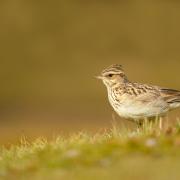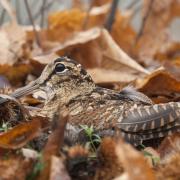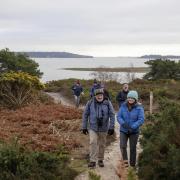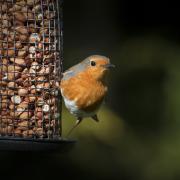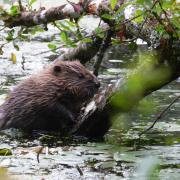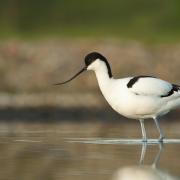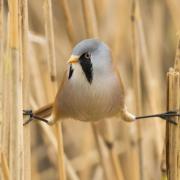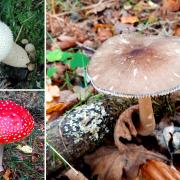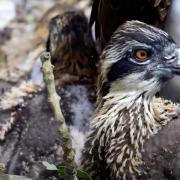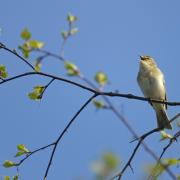The wild and rocky landscape of the Isle of Portland is home to some very rare species, so defeating a rampant invader has been a top priority for Dorset Wildlife Trust

There are few places in the county more dramatic than the Isle of Portland. Glittering on the horizon, this rugged and remote part of Dorset is battered by the waves of the English Channel and yet its rocky limestone habitat is home to some very rare species of flora and fauna. Yet despite all its natural splendour, something sinister was lurking in the undergrowth, engulfing everything in its path; a threat so severe that it was putting the future of much of the island’s wildlife in serious peril.
This fearless foe is Cotoneaster, a non-native invasive plant that has been smothering and eventually destroying much of Portland’s native plants and the wildlife it supports. It has caused nothing short of chaos for wildlife conservation in recent years. Taking up residence in many of the disused quarries dotted throughout the island, the Cotoneaster horizontalis spread far and wide until much of the island’s unique limestone grassland was completely covered.
In 2010 Dorset Wildlife Trust (DWT), in partnership with Natural England, Butterfly Conservation, Plantlife, the Dorset Environmental Records Centre and Dorset County Council, decide that enough was enough and this foreign invader had to be stopped. And so the Portland Living Landscapes Project was born - its main objective - to stop the spread of cotoneaster and other invasive plants on Portland and so restore the natural balance to this unique and rare Dorset landscape.
This was no easy task, a point that was not lost on DWT Portland Living Landscapes Project Officer Sam Hamer. “It was a huge undertaking as the invasive species had smothered a wide area of the island’s grassland. In fact it had got so bad that it was actually stopping other conservation work happening on the island.”
The project’s initial aim was to remove the threat that these invasive plants posed towards the limestone grasslands on Portland. “In those first few years 90% of our work was centred on targeted chemical application and the subsequent removal and burning of the cotoneaster so the limestone grassland could recover. Three years on we can see the extent that these invasive species had spread and the threat it posed to all the rare wildlife that inhabits the island.”
Now in its third year of funding, after receiving a grant worth £850,000 from the Viridor Credits Landfill Community Fund, the Portland Living Landscapes Project has cleared 200 hectares of limestone grassland across 14 different sites. “Without a doubt, the project has been a massive success,” says Sam. “We had hoped to see some positive results within the life of the project but what the data is showing now has really surpassed all expectations.
“After removing over 200 metric tonnes of waste plant material, the islands limestone grasslands are once again thriving with all manner of wildlife. These include an extremely rare form of the Silver Studded Blue Butterfly and the Richardson’s Case-bearer Moth which is only found in Dorset.”
Local volunteers also played their part in helping the project achieve its great success. “All their hard work has paid off.,” says Sam “We were also able to up-skill and train some local people to allow them to get qualifications in conservation and land management.”
With the spread of cotoneaster now under control, the Portland Living Landscapes Project will continue to manage and monitor the land. “We want to make sure that the work we have done doesn’t just last for 10 years but for 50, preserving the wildlife on Portland for future generations. And with the creation of the Portland Quarries Nature Park people can now see all the fantastic wildlife that lives on their doorstep.”
***
Visit Portland Quarries Nature Park
Portland Quarries Nature Park, established in early 2014, links several areas of wildlife interest across the Isle of Portland, including DWT’s King Barrow Quarry Nature Reserve, Tout Quarry Nature Reserve – which is home to a stone sculpture park, showcasing the work of local stonemasons and artists - and Inmosthay Quarry - which is owned by Albion Stone but has been restored back to its natural wild environment. Over the next few years more quarries will be added to the nature park, including Trade Quarry, Bowers Quarry and Inmosthay South.
Directions
King Barrow Quarries Nature Reserve: On the Isle of Portland take the A354, climb the hill and look for small parking area set back off the east side of the road. Entrance to the reserve is marked by a finger post just off Yeates Road.
Tout Quarries Nature Reserve
On the Isle of Portland take the A354 up the hairpin bend at Priory Corner. At the Roundabout take the last exit onto Wide Street, after ¼ mile turn right onto Trade Croft Road. The car park is on the right hand side at the end of the road.
--------------------------------------------------
Read on








